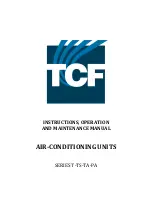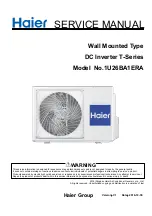
17
English
8. Precautions on refrigerant piping
• Do not allow anything other than the designated refrigerant to get
mixed into the refrigerant cycle, such as air, nitrogen, etc. If any
refrigerant gas leaks while working on the unit, ventilate the room
thoroughly right away.
• Use R410A only when adding refrigerant.
• Installation tools:
Make sure to use installation tools (gauge manifold, charge hose,
etc.) that are exclusively used for R410A installations to withstand
the pressure and to prevent foreign materials (e.g., mineral oils and
moisture) from mixing into the system.
• Vacuum pump:
- Use a 2-stage vacuum pump with a non-return valve.
-
Make sure the pump oil does not flow oppositely into the system
while the pump is not working.
- Use a vacuum pump which can evacuate to 500 microns (66.5 Pa).
• In areas where compliance with the Chicago Mechanical Code is
required, install a relief valve connection kit (DPRK06). For installa-
tion of the relief valve connection kit, refer to the installation manual
delivered with the kit.
Protection against contamination when installing pipes
Take measures to prevent foreign materials like moisture and contami-
nation from mixing into the system.
Installation
Protection method
More than a month
Pinch the pipe
Less than a month
Pinch or tape pipe
Regardless of the period
Block all gaps in the holes for passing out piping and wiring using seal-
ing material (field supply) (the capacity of the unit will drop and small
animals may enter the machine).
Example:
passing piping out through the front.
•
Close the areas marked with
.
( When the piping is routed from
the front panel.)
Use clean pipes only.
• Hold the pipe end downwards when removing burrs.
• Cover the pipe end when inserting it through a wall so that no dust
or dirt enters the pipe.
NOTE
• After all the piping has been connected, make sure there is no gas
leak. Use Dry Nitrogen to perform a gas leak detection.
• After cutting the slit holes, it is recommended to remove burrs in the
slit holes and paint the edges and areas around the edges using the
repair paint to prevent rusting.
8.1. Caution for brazing
• Make sure to blow through with Dry Nitrogen when brazing. Blowing
through with Dry Nitrogen prevents the creation of large quantities
of oxidized film on the inside of the piping. An oxidized film ad
-
versely affects valves and compressors in the refrigerating system
and prevents proper operation.
• The Dry Nitrogen pressure should be set to 2.9 psi (0.02 MPa (i.e.,
just enough so it can be felt on the skin)) with a gauge manifold.
1
2
3
4
5
6
6
1 Refrigerant piping
2 Part to be brazed
3 Taping
4 Hands valve
5 Gauge manifold
6 Dry Nitrogen
Do not use anti-oxidants when brazing the pipe joints. Residue can
clog pipes and break equipment:
•
Do not use flux when brazing copper-to-copper refrigerant piping.
Use phosphor copper brazing filler alloy (BCuP) which does not
require flux.
•
Flux has an extremely harmful influence on refrigerant piping
systems. For instance, if chlorine based flux is used, it will cause
pipe corrosion or, in particular, if the flux contains fluorine, it will
deteriorate the refrigerant oil.
8.2. Connecting the refrigerant piping
8.2.1.
Decide front or side (bottom) connection
Installation of refrigerant piping is possible as front connection or side con-
nection (when taken out from the bottom) as shown in the figure below.
1
2
3
1 Left-side connection
2 Front connection
3 Right-side connection
• When the front connection, remove the slit hole of the piping intake
and lead out piping to the piping intake.
slit hole
slit
Cut
• When side connections, remove the through hole cover on the bot-
tom frame and lead out the piping from the bottom frame.
Remove
through hole
cover
through hole
Attach the screw to
the original position
<After removing the through hole cover>
01_EN_Main_VRV6_HP_IM.indd 17
01_EN_Main_VRV6_HP_IM.indd 17
2022/12/09 12:06:23
2022/12/09 12:06:23















































